Part 4: Dances of the Balkans
14 Dances of Romania and Moldova
1. Geography
Romania is a country located in the far east of Europe. It is bordered in the south with Bulgaria, on the North by Ukraine, on the east by the Black Sea and on the west by Serbia and Hungary. Moldova, an independent country, is located just to the northeast of Romania, tucked in next to Ukraine. Culturally, the two countries are very closely linked, but have distinct political histories.
Modern Romania has seven major regions. The Banat is a fertile plain in the west. Transylvania includes a northern extension of the Banat plain and a range of rugged mountains in the central area called the Carpathians. Rolling foothills make up Moldova and Bucovina in the northeast. On the eastern seaboard, Dobrogea features a lengthy coastline along the Black Sea. Finally, Muntenia and Oltenia form a riparian area and delta along the Danube in the south along the border with Bulgaria and contain rich oil-producing lands. Each of these regions has a unique music and dance culture.
Moldova (also known as Bessarabia, Moldavia and Moldovia) has long been ruled by its neighbors to the east and north: Russia and Ukraine (and the Soviet Union when it existed). It is now an independent country. Linguistically and culturally however, it is closer to its neighbor on the west, Romania. Within Moldova, there is a tiny breakaway republic called Transnistria (or Pridnestrovie), which has not been widely recognized by the countries of the world. Transnistria is located on the border with the Ukraine. For the most part in the rest of this reading we will be concentrating on Romanian music and dance, but the majority of what is discussed here is also true of Moldova. The country of Moldova should not be confused with the Romanian region of Moldova which is on its western border. The music and dances of Romanian Moldova and the country of Moldova form a clear cultural continuum, however.

2. Language and Culture
The Romanian language has a fascinating history, it’s the largest Romance language (i.e., a language descended from Latin) spoken in Eastern Europe . In ancient times, Romania was known as the Dacia. In the first century A.D., the Romans conquered Dacia and the people adopted Latin, which eventually evolved into Romanian. This language is related to Spanish, Italian, French, and Portuguese. But it has many unique features. It has a lot of loan words from the Slavic languages spoken around it, as well as from the Hungarian minorities within its borders. It also has acquired a number of grammatical characteristics associated with neighboring Balkan languages. For example, the Romanian definite article -ul (cognate to Spanish el and Italian il) is a suffix on the word it attaches to, rather than appearing before the noun. This is a characteristic of languages spoken in the rest of the Balkans (for example, in Bulgarian and Macedonian, the definite article -to is also a suffix rather than an independent word).
The land and resources of Romania have been prized by just about every conquering group throughout history, including the Mongols, Goths, Persians, Slavs, Macedonians, the Saxons, Bavarians, Romans, The Austro-Hungarian Empire, and The Ottoman Empire. After WW I, The Austro-Hungarian Empire was broken up with the Treaty of Trianon and the borders of present-day Romania were set.
Until the 1980s, the country had several active and distinct ethnic enclaves. Germans hailing from Bavaria populated the Banat around Timișoara in western Romania. They practiced Western Catholicism, as opposed to the Romanian brand of Orthodoxy; and they spoke many dialects of German. They retained their culture and music and dance, preferring accordionists and brass bands that played waltzes and polkas from “the old country.” They also retained their festivals, such as the Kirchweih, which was an elaborate week-long harvest festival, inherited from Medieval times, that included many rituals as well as festivities.
Hungarians peopled the area north of The Banat and west of the Carpathians, centered in and around Sibiu in the Transylvania. They retained their Hungarian language, Catholic religion, and customs – including music, dance and costuming that sounded and looked very Hungarian. One particular group of ethnic Hungarians in eastern Moldova, the Csángó, has a unique musical and dance style.
The Gagauz are a group of people in Moldova who speak a Turkic language related to Turkish, but who practice Eastern Orthodox Christianity. They are related to the Gagauz who live in the Ukraine and Bulgaria. Their dances and music are not particularly Turkish in style, except for the fact that they often do dances in 9/8 time which is a characteristic meter for Turkish dances and is rare in Romanian dances.
Armenians came to Romania about 1,000 years ago, bringing the Armenian Apostolic Christian Church, unique customs, and cultural artifacts with them. Most notably they became renowned as mathematicians and architects who designed many of the distinctive churches in east-central Romania.
Many people from various Slavic nations formed ethnic minorities. These include Ukrainians and Russians in Moldova and Transnistria and Serbs in the Banat area. Another group were the Roma . The Roma are descended from migrants from India. They speak a language called Romani, which is not related to Romanian except to the extent they are both Indo-European languages. The Roma are important figures in cultures throughout the Balkans because they are often the primary musicians who play at social events like weddings and festivals. Unfortunately, during the 1980s, the post-WWII Communist regime, under the regime of Nicolae Ceausescu, began pogroms against these ethnic minorities. To avoid destruction many of these people left everything they had and fled the country to start their lives over.
3. Folk Costumes
Romanian women wear long-sleeved white blouses and white mid-calf skirts. Elsewhere in the Balkans, village costume decoration tends to feature floral designs. While floral decoration is not unknown in Romania, villagers’ old-style costume decoration was characterized largely by geometric patterns. Ladies created embroidered wide patterns –called altiță—at the shoulders of their blouses, often in red, blue, and black. They also decorated necks and sleeves with embroidered vertical stripes and sewed a horizontal stripe at the cuff. Over their skirts they wore long black woven aprons, front and back. These aprons had golden or silver top-weavings in geometric designs. Often, they wore black vests with additional embroidery or braiding and a cloth head covering.
Village men’s costumes are simpler—a white tunic over wide-legged white pants. Sometimes their tunics had a small altiță decoration at the shoulder and some embroidery around the cuff and at the hem. Often, they had a wide belt made of leather or woven and decorated with geometric designs. Black vests with embroidery and red or green pompoms or tassels would complete the outfits. Mountain villagers wear a white woolen vest heavily embroidered in red and black with geometric designs. They might also have fur pieces sewn to the neck and around the around the fronts and hems of their vests.
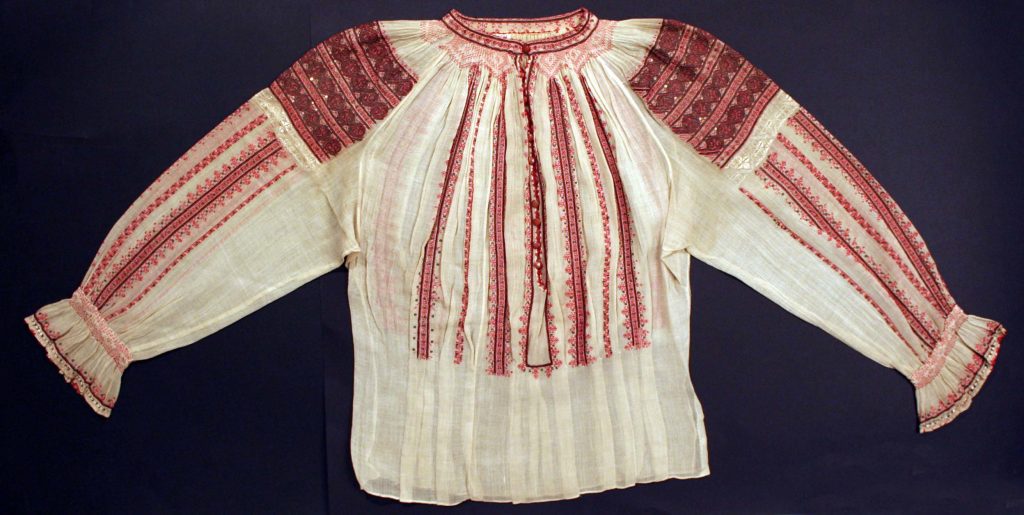
Figure 14.2: Women’s blouse with altiță
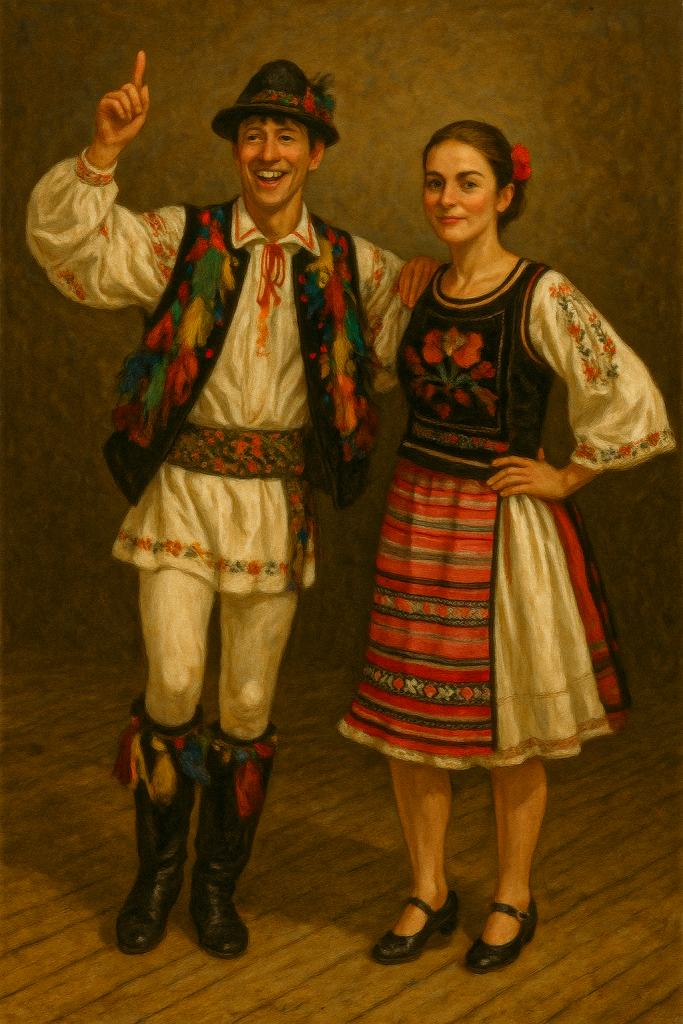
4. Music
When you hear Romanian music, the instrument that is most prominent is the violin. But Romanian folk bands include many other instruments such as the cobză (guitar), trumpets (especially in Moldova and Banat) and the double bass. Most likely Romanians inherited the țimbal (cimbalom) from the ethnic Hungarians who live nearby. Favorite wind instruments include flutes (fluier), the panpipe (nai), cimpoi (bagpipes), and the caval, which is a long shepherd’s pipe, and the ocarină.
The Romanian taragot is descended from the Turkish double-reeded oboe-like Zurna. Romanians adapted the instrument from the Turks during the Turkish wars of the Middle Ages. After the Austrians expelled the Turks in the late 1800s, the Hungarians had a keyed single reed instrument called the taragoata, which the Romanians adopted as the taragot. It has a sound as hauntingly mournful as the oboe, but unique unto itself.
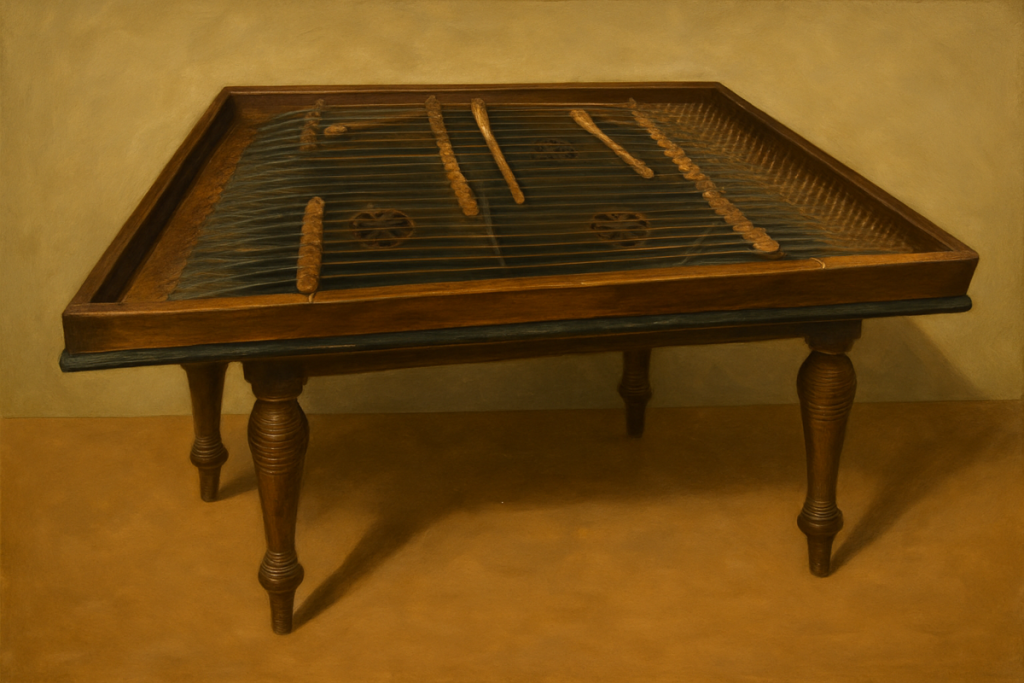
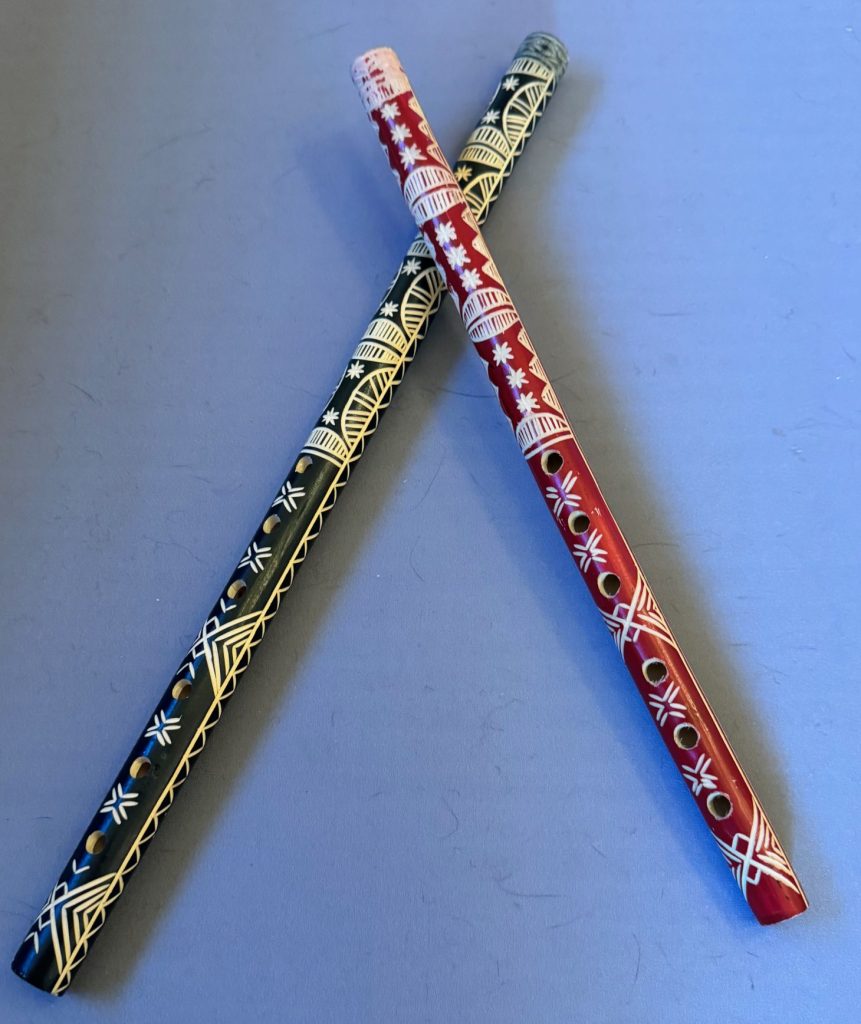
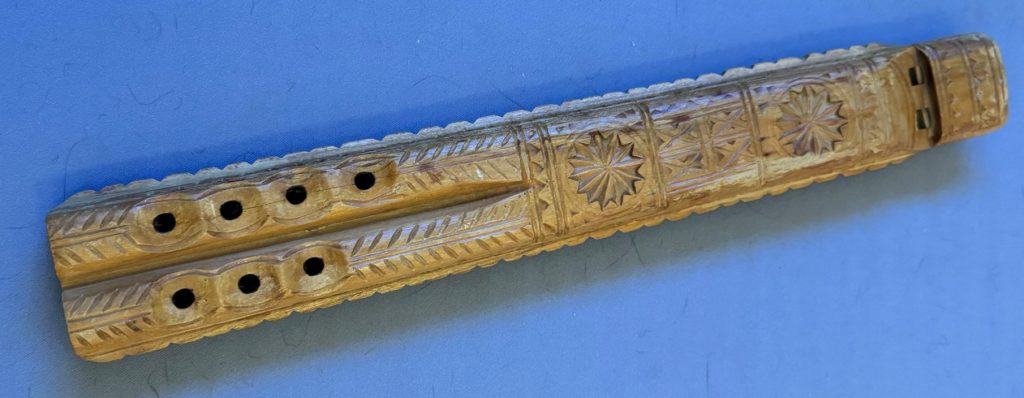
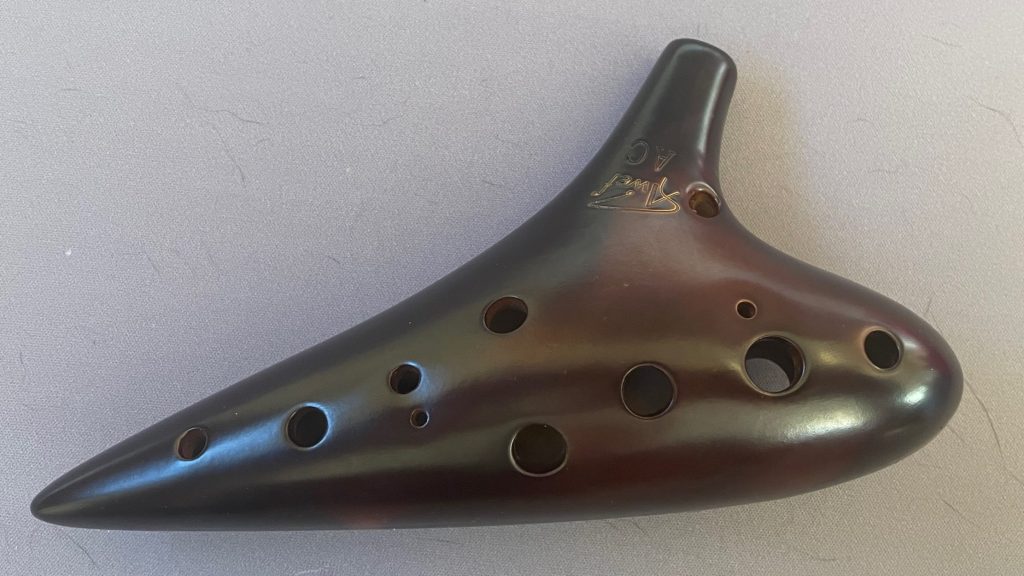
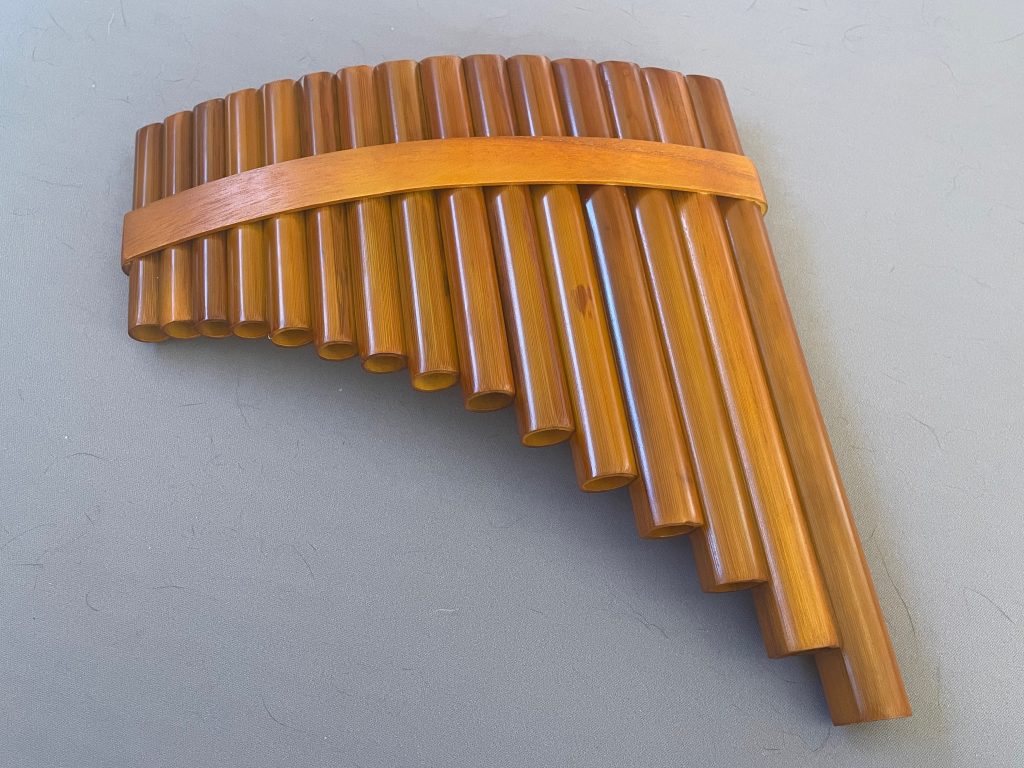
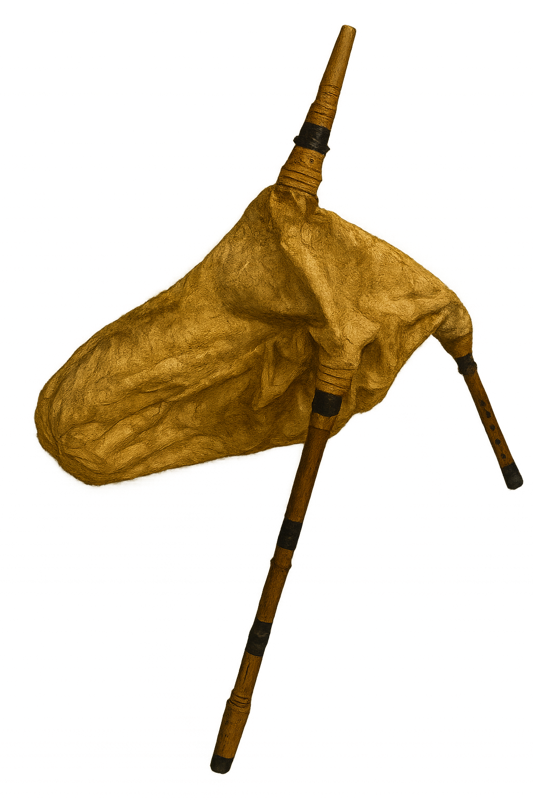
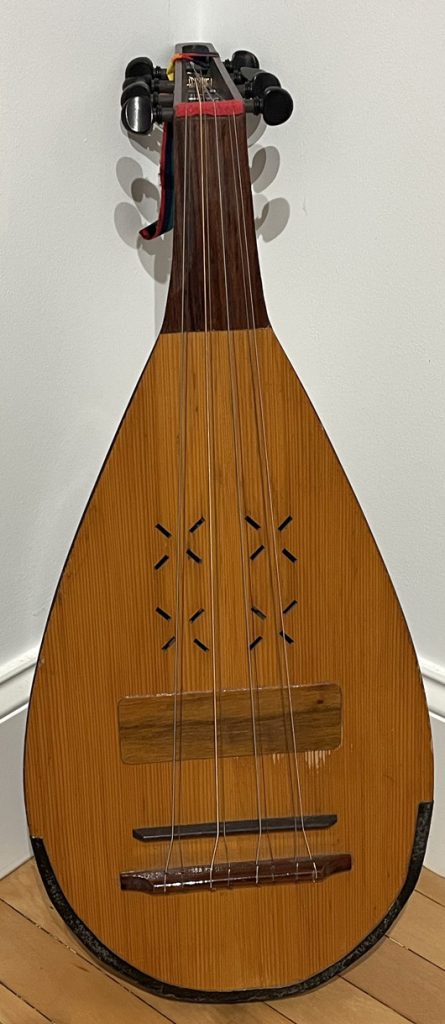

- Cimpoi, Caval, Fluier, Ocarina: https://youtu.be/o7TTr3QNN6s
- Cobză: https://youtu.be/Fww-C8QWSPw
- Taragot: https://youtu.be/tCK8WScqIOI
- Moldovan tunes on the Ţsimbal: https://youtu.be/Um3n5LAtuB8
- Taraf de Haidouks (One of the best Roma bands playing traditional music): https://youtu.be/PzrxvpG2_Sk
- Fanfare Ciocârlia (One of the best Roma bands playing brass instruments): https://youtu.be/QiHmiZQNgL4
- Zamfir playing the traditional tune Ciocarlia: https://youtu.be/W5FOuI-jQpc
5. Dances
Romanian dance includes much characteristic vigorous stamping and arm swinging as we find in the Sârba dances. But you also find dances that feature gentle swaying of the body in quarter circles or from side to side. While lots of Romanian dances are based on the Hora—circle dances—Romanians also enjoy couple dances and Brâul (brâul means belt, but belt dances are exceedingly rare in Romania; another possible origin for the name is that these dances were based on French Branle court dances). In the region called Dobrogea, dances feel more down-to-earth. Here they do a lot of twisting and stamping accompanied by a significant amount of arm swinging and arm pumping.
Romanian dance is seldom a quiet or sedate experience. Romanians whistle stridently, or they may shout or clap. The shouts are called strigaturi and mark one unique characteristic of Romanian dance. Romanian men shout these rhythmic chants as they dance. They are spur-of-the-moment creations, often done in rhyming couplets or 4-liners—little satiric poems or directions about the dance steps. Often one man shouts his inspired comments in rhythm with the dance; at other times they use a call and response format. Some examples translated into English here:
“On the spot, in place. Dance until the rosemary flowers.”
“Hey you guys; let’s move—hey! Move; move with the stamps!”
“You can eat but you don’t dance; you will not fit in your pants!”
Common meters are the 2/4, 3/4 and 6/8; but Slavic influence has resulted in dances with more complex meters, such as 7/16 (Geamparalele), 10/16 and 11/16. Adding complexity, the Gagauz people and the Aromanian people in Romania also do dances with 5/8 or 9/8 meters as well.
- Moldovan Dance with strigaturi: https://youtu.be/Gl4eIgSmEcI
- Joc with Strigaturi: https://youtu.be/t343WTNupJI
- Invirtita: https://youtu.be/H8uSH4L807M
- Sârba: https://youtu.be/OB5Z0CAQ4lw
6. Călușari
No discussion of Romanian dance would be complete without a discussion of the Călușari, the male ritual dancers. Secret societies of Călușari dancers wear distinctive costumes and perform their spectacular acrobatic dances during change-of-season festivals especially in the spring and autumn. They combine rapid stamping, clapping, leaping, squatting, kicking, cartwheels and heel-clicking into a spectacular dance.
Călușari dancers often wear white pants and thigh-length white tunics, heavily embroidered in geometric red patterns at the collar, shoulder, and cuffs, as well as down the sleeves and on the hem. They cinch their tunics at the waist with colorful woven red belts that sport narrow red slats, and across their chests they have wide red woven straps crossed in a large X. The Călușari used to carry swords and clubs, which have morphed into carrying long, colorfully decorated sticks. They hold the sticks vertically and use them to launch themselves into leaping acrobatics. Călușari wear bells and tassels on their leggings and they adorn their distinctive hats with spangles and ropes of shiny pearls and long colorful ribbon streamers that hang down their backs below their tunics—all to ward off evil spirits, thereby encouraging health and happiness to the members of the village households that they visit. It is likely that the Călușari represent pre-Christian hunting rituals. Their symbol is the horse and many of the steps they do represent horse-like prancing. However, some clubs have hats decorated around the crowns with garlands of flowers. Overall, the costumes bear a striking resemblance to the costumes worn by Morris Dancers in England. Morris Dancers also wear bells on their leggings, wear crossed red straps, wear hats decorated with flowers, and carry sticks! The coincidence is remarkable and we can only speculate about why it exists. Some scholars speculate that Morris dancers and călușari are both remnants of early Indo-European horse cults.
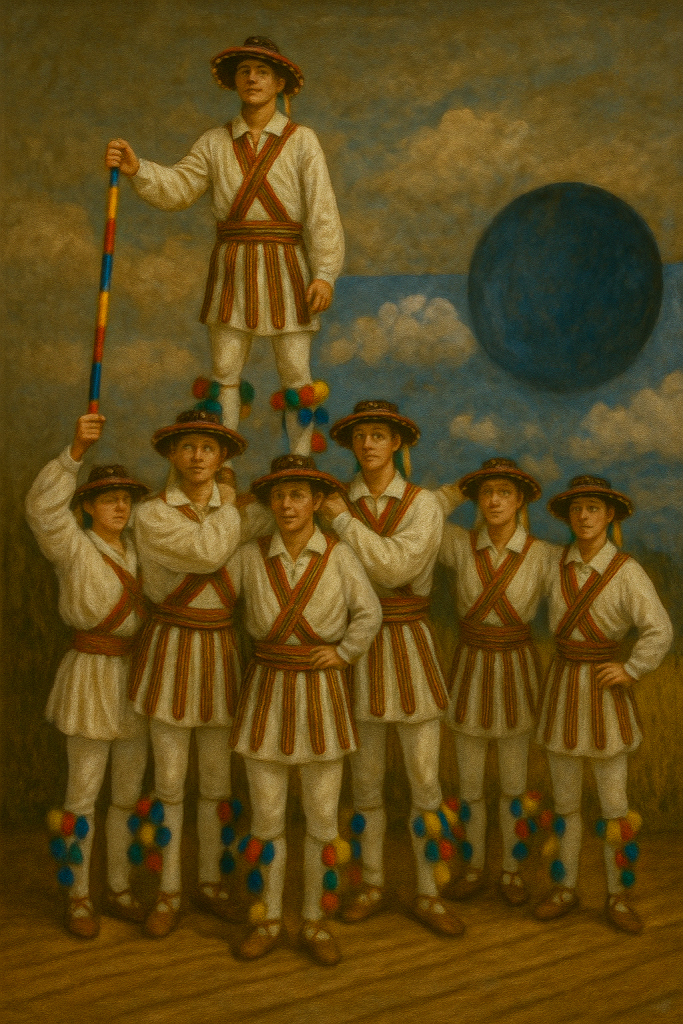
- Călușarii Video: https://youtu.be/sImsZJ7cX0o
Further Reading
- Giurchescu and Bloland (1995); Grindea, Miron and Carola Grindea (1952). For full citations, see references section at the end of the book.
- http://www.socalfolkdance.org/articles/character_of_romanian_dance_vasilescu.htm
- https://www.sfdh.us/encyclopedia/romanian_dance_and_music.html
Some Suggested Dances for Teaching
- Alunelul: http://folkdancemusings.blogspot.com/2014/01/alunelul-romania.html
- Arnuata: https://folkdancemusings.blogspot.com/2019/06/arnauta-albaniaromania.html
- Colindul Voinicului: https://folkdancemusings.blogspot.com/2021/12/colindul-voinicului-romania.html
- De Strigat: http://folkdancemusings.blogspot.com/2014/07/de-strigat-romania.html
- Hora de Langesti: http://folkdancemusings.blogspot.com/2014/05/hora-de-langesti.html
- Joc in Patru: http://folkdancemusings.blogspot.com/2014/05/joc-in-patru-de-la-targul-lapus-romania.html
- Tarina De La Abrud: http://folkdancemusings.blogspot.com/2014/08/tarina-de-la-abrud-romania.html
- Ciuleandra: http://folkdancemusings.blogspot.com/2014/05/ciuleandra-romania.html
Discussion Questions
Discussion Question 1
An internationally known dance ethnographer, teacher and choreographer goes to Boston and teaches a dance that they have personally researched and learned from a Romanian village. Later this expert comes to Tucson and teaches the same dance they taught in Boston, but with a different ordering of the figures. You look online and see a group of villagers doing a dance with that same title, but it has yet again a different order of figures; moreover, it also includes a figure that your teacher didn’t mention in their teaching or in their written description of the dance. Which of the three iterations of this dance are “correct”, if any, and why?
Discussion Question 2
Moldavia and Romania have been politically divided for over a century, but their music and dance traditions are very similar. Why should this be the case?
Media Attributions
- Figure 14.1: Map of Romania and Moldova © John W. W. Powell, used with permission. Addition GIS data cited in map.
- Figure 14.2: Women’s blouse with altiță © Metropolitan Museum of Art. is licensed under a CC0 (Creative Commons Zero) license
- Figure 14.3: Typical Romanian Folk Dance Costumes © Saman Meihami, with the assitance of ChatGPT. Used with permission
- Figure 14.4: Ţambal or Cymbalom © Andrew Carnie with the assistance of ChatGPT
- Figure 14.5: Fluiers © Shirley Hauck, personal collection. Used with permission
- Figure 14.6: Double Fluier © Shirley Hauck, personal collection. Used with permission
- Figure 14.7: Ocarină © Andrew Carnie, personal collection
- Figure 14.8: Nai (Pan flute) © Andrew Carnie, personal collection
- Figure 14.9: Cimpoi © Musical Instrument Museum, Phoenix. Used with permission
- Figure 14.10: Cobză © Tom Pixton collection. Used with permission
- Figure 14.11: Taragot © Musical Instrument Museum, Phoenix. modified with ChatGPT. Used with permission
- Figure 14.12: Căluşari Costume © Saman Meihami, with the assistance of ChatGPT. Used with permission

